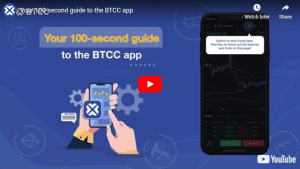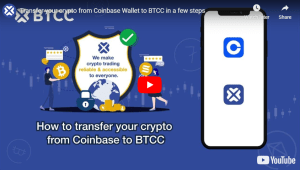Crypto ATM Scam (2025 Guide): How to Spot, Avoid, and Report Bitcoin ATM Fraud
- What Is a Crypto ATM?
- ️ What Is a Crypto ATM Scam?
- How a Crypto ATM Scam Works (Step-by-Step)
- Common Types of Crypto ATM Scams (2025 Update)
- 2025 Crypto ATM Scam Statistics
- Why Scammers Use Crypto ATMs
- Real-Life Case Studies
- How to Identify a Crypto ATM Scam
- How to Avoid a Crypto ATM Scam
- How to Report a Crypto ATM Scam
- How Operators Are Fighting Back
- Global Regulation Efforts (2025 Edition)
- Comparing Crypto ATM Scams vs Traditional Scams
- Expert Opinions
- What To Do If You Already Used a Bitcoin ATM in a Scam
- How to Use Crypto ATMs Safely
- Future Outlook: Are Crypto ATMs Still Safe in 2025?
- FAQs
- Conclusion: Knowledge Is the Best Defense
- How to Trade Crypto on BTCC?
- BTCC FAQs
What Is a Crypto ATM?
How They Work
️ What Is a Crypto ATM Scam?
/ You can claim a welcome reward of up to 10,055 USDT🎁\
How a Crypto ATM Scam Works (Step-by-Step)
Common Types of Crypto ATM Scams (2025 Update)
2025 Crypto ATM Scam Statistics
According to the FTC Fraud Report (2025):
Why Scammers Use Crypto ATMs
| Feature | Description |
|---|---|
| Anonymity/Pseudonymity | No legal names or traditional bank accounts required to transact. |
| Irreversibility | Once confirmed, crypto transactions cannot be canceled or reversed. |
| Speed | Funds can be transferred globally, often in minutes or instantly. |
| Accessibility | Crypto ATMs and other on-ramps are available in many public locations. |
| Low Public Awareness | Many potential users do not understand blockchain technology or how to use digital wallets securely. |
Real-Life Case Studies
How to Identify a Crypto ATM Scam
Warning Signs:
Safety Checklist:
How to Avoid a Crypto ATM Scam
Scammers use urgency to trap you. Always stop and verify.
Only send crypto to people or platforms you trust completely.
Look for operators with good reviews, like Bitcoin Depot, CoinFlip, or RockItCoin.
Especially older people — the most common victims.
/ You can claim a welcome reward of up to 10,055 USDT🎁\
How to Report a Crypto ATM Scam
If you think you’ve been scammed:
How Operators Are Fighting Back
Top Bitcoin ATM companies now integrate:
Global Regulation Efforts (2025 Edition)
| Country/Region | Regulatory Body & Framework | Key Requirements & Impact |
|---|---|---|
| USA | FinCEN (Financial Crimes Enforcement Network) | KYC verification for transactions over $1,000; improved transaction traceability |
| UK | FCA (Financial Conduct Authority) | Banned unregistered crypto ATMs; reduced fraud and illegal operations |
| EU | MiCA (Markets in Crypto-Assets) | Comprehensive licensing and oversight for crypto vending machines |
| Australia | AUSTRAC (Australian Transaction Reports) | Mandatory reporting of large ATM transfers; increased transparency |
Comparing Crypto ATM Scams vs Traditional Scams
| Scam Type | Payment Method | Reversibility | Most Targeted Victims |
|---|---|---|---|
| Crypto ATM Scam | Bitcoin, USDT, ETH | No | Elderly, inexperienced online users |
| Bank Transfer Scam | Wire transfer | Sometimes | Businesses, rental applicants |
| Gift Card Scam | Retail gift cards | No | Seniors, tech support victims |
| Phishing Scam | Bank login theft | Partial | General online users |
Expert Opinions
What To Do If You Already Used a Bitcoin ATM in a Scam
How to Use Crypto ATMs Safely
Future Outlook: Are Crypto ATMs Still Safe in 2025?
FAQs
Conclusion: Knowledge Is the Best Defense
For more detailed market analysis, strategies, and educational resources, visit BTCC Academy and stay ahead of the curve in the rapidly evolving crypto space.
How to Trade Crypto on BTCC?
This brief instruction will assist you in registering for and trading on the BTCC exchange.
Step 1: Register an account
The first step is to hit the “Sign Up” button on the BTCC website or app. Your email address and a strong password are all you need. After completing that, look for a verification email in your inbox. To activate your account, click the link in the email.

Step 2: Finish the KYC
The Know Your Customer (KYC) procedure is the next step after your account is operational. The main goal of this stage is to maintain compliance and security. You must upload identification, such as a passport or driver’s license. You’ll receive a confirmation email as soon as your documents are validated, so don’t worry—it’s a quick process.

Step 3. Deposit Funds
After that, adding money to your account is simple. BTCC provides a range of payment options, such as credit cards and bank transfers. To get your money into your trading account, simply choose what works best for you, enter the amount, and then follow the instructions.
- Fiat Deposit. Buy USDT using Visa/Mastercard (KYC required).
- Crypto Deposit. Transfer crypto from another platform or wallet.

Step 4. Start Trading
If you wish to follow profitable traders, you might go for copy trading, futures, or spot trading. After choosing your order type and the cryptocurrency you wish to trade, press the buy or sell button. Managing your portfolio and keeping track of your trades is made simple by the user-friendly interface.

Look more for details: How to Trade Crypto Futures Contracts on BTCC
BTCC FAQs
Is BTCC safe?
Based on its track record since 2011, BTCC has established itself as a secure cryptocurrency exchange. There have been no reports of fraudulent activity involving user accounts or the platform’s infrastructure. By enforcing mandatory know-your-customer (KYC) and anti-money laundering (AML) procedures, the cryptocurrency trading platform gives consumers greater security. For operations like withdrawals, it also provides extra security features like two-factor authentication (2FA).
Is KYC Necessary for BTCC?
Indeed. Before using BTCC goods, users must finish the Know Your Customer (KYC) process. A facial recognition scan and legitimate identification documents must be submitted for this process. Usually, it is finished in a few minutes. This procedure has the benefit of strengthening the security of the exchange and satisfying legal requirements.
Because their accounts will have a lower daily withdrawal limit, those who do not finish their KYC are unable to make deposits. It should be noted that those who present a legitimate ID without a facial recognition scan will likewise have restricted withdrawal options.
Is There a Mobile App for BTCC?
Indeed. For users of iOS and Android, BTCC has a mobile app. The exchange’s website offers the mobile app for download. Since both the web version and the mobile app have the same features and capabilities, they are comparable.
Will I Have to Pay BTCC Trading Fees?
Indeed. BTCC levies a fee for trade, just like a lot of other centralised exchanges. Each user’s VIP level, which is unlocked according to their available money, determines the different costs. The BTCC website provides information on the charge rates.
Can I Access BTCC From the U.S?
You can, indeed. According to its website, BTCC has obtained a crypto license from the US Financial Crimes Enforcement Network (FinCEN), which enables the cryptocurrency exchange to provide its services to investors who are headquartered in the US.
According to BTCC’s User Agreement document, its goods are not allowed to be used in nations and organisations that have been sanctioned by the United States or other nations where it has a licence.
BTCC Guide:
- How to Trade Crypto Futures Contracts on BTCC
- BTCC Guide-How to Deposit Crypto on BTCC?
- What is Crypto Futures Trading – Beginner’s Guide
- What is Leverage in Cryptocurrency? How Can I Trade at 100X Leverage?
- BTCC Review 2024: Best Crypto Futures Exchange
Crypto Buying Guides:
- How To Buy Bitcoin (BTC)
- How To Buy Picoin
- How To Buy Ethereum (ETH)
- How To Buy Dogecoin (DOGE)
- How To Buy Pepe Coin (PEPE)
- How To Buy Ripple (XRP)
Crypto Prediction:
- Ethereum (ETH) Price Prediction 2024, 2025, 2030 — Will ETH Reach $10,000?
- Ethereum Price Prediction 2024, 2025, 2030: How High Can ETH Go in 2024?
- Bitcoin (BTC) Price Prediction 2024, 2025, 2030 — Is BTC a Good Investment?
- Ripple (XRP) Price Prediction 2024, 2025, 2030 — Will XRP Reach $1 After SEC Lawsuit?
- Pi Coin Price Prediction 2024,2025,2030 — Is Pi Coin a Good Buy?
- Pepe (PEPE) Price Prediction 2024, 2025, 2030 – Will PEPE Reach $1










